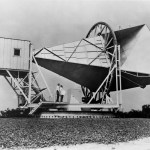vacuum
Aristotle thought that there could be no lasting void in the natural order, that any emptiness would be instantaneously filled. Of course Aristotle was full of batty ideas. But this one came to be rephrased by philosophers and Vulcans alike as "nature abhors a vacuum," enduring as a powerful metaphor if not a precisely factual truth. In terms of critical thinking, scientists too abhor a vacuum, and are usually eager to fill in the blanks. On Pharyngula, PZ Myers criticizes a review of long-established brain anatomy, freshened with primary colors and a hypothesis that makes no sense.…
"Orbiting Earth in spaceship, I saw how beautiful our planet is. People, let us preserve and increase beauty, not destroy it!" -Yuri Gagarin
Fifty-two years ago today, the first human being left Earth, and we began our journey into outer space. But back in 1961, we didn't really know how far outer space stretched, or where all the matter and energy in the Universe came from.
Image credit: NASA, 1962.
That all changed with the discovery of the Cosmic Microwave Background (by Penzias and Wilson, with the Horn Antenna, above), and subsequent measurements that led us to the Big Bang picture of…
Over at Confused at a Higher Level, Melissa offers an alphabetical list of essential supplies for a condensed matter experimentalist at a small college. This is a fun idea for back-to-school time, so I'll steal it, and offer the following alphabetical list of essentials for Atomic, Molecular, and Optical physics at a small college, kind of a condensed version of the three part series I did a few weeks ago.
A is for Acousto-optic modulator This is a device that uses sound waves in a crystal to deflect light and shift its frequency. It's essential for rapid control of laser properties.
B is for…
Last week's series of posts on the hardware needed for laser cooling and trapping experiments dealt specifically with laser-cooling type experiments. It's possible, though, to make cold atoms without using laser cooling, using a number of techniques I described in two posts back in January. Those didn't go into the hardware required, though, so what's different about those techniques in terms of the gear?
Less than you might think. In fact, most of the labs that do these experiments use exactly the same sorts of equipment that laser coolers do. Including some lasers.
It's not all of them, but…
Over in the reader request thread, Richard asks for experimental details:
I'd be interested in (probably a series) of posts on how people practically actually do cold atoms experiments because I don't really know.
I needed to take some new publicity photos of the lab anyway, so this is a good excuse to bust out some image-heavy posts-- lab porn, if you will. There are a lot of different components that go into making a cold-atom experiment, so we'll break this down by subsystems, starting with the most photogenic of them, the vacuum system:
(Click on that for a much bigger version.)
This…
How does a suction cup work? It is all about the atmosphere. Here is a demo. Take some type of "suction cup" device. In this case, I used a toy dart. Stick it to something smooth and lift it up. Like this:
What lifts up the metal block? The atmosphere. Diagram time:
But this isn't a very realistic diagram. Actually, the suction cup would be pushing down on the block because the force from the atmosphere would be too large to balance with the weight. Let me put some numbers in here. Suppose this is an aluminum block - I just going to pretend it is 4cm on a side (and a cube). In…
Check out this thing.
That is where the guy (Jem Stansfield of BBC's Bang Goes the Theory) shows how he built this thing. Here is part 2 where he uses it to climb a building.
Here are some questions:
Why does it not matter how powerful the vacuum is?
How does a vacuum cleaner work anyway?
How does the vacuum cleaner work?
I know this is not HowStuffWorks.com, but I guess I should show some stuff. The cool thing about a vacuum cleaner (think shop vac so that I don't have to deal with the brushes) is that it is just one thing - a fan. The fan essentially moves air out of the vacuum part of…
I stumbled on this flash game Bloons. The basic idea is that you (the monkey) throw these darts and try to pop some balloons.
Well, what is the motion of these darts like? Is it constant acceleration? Time to pull out the free and awesome Tracker Video Analysis.
I threw a few shots and captured the screen with Mac OS X's quicktime X (which does screen recordings now). Then I chose a few of the motions to analyze. I was going to use Tracker's autotracker feature, but I am not sure how well it would work since the dart changes orientation (of course I didn't even try this to see if it…
Bret Underwood, a friend of mine from my time in Madison, WI, saw my post on String Theory, and took issue with my statement that it wasn't testable. I'm still standing behind what I said, but let's address what Bret has to say.
I donât understand your argument above for why string theory is untestable. In fact, it seems to me you just outlined the best possible case for string theory! What you said above is that if I have a string theory construction of a phenomenon (say, the Standard Model or Inflation), which uses a set of parameters X, and makes some predictions, then I can find another…

